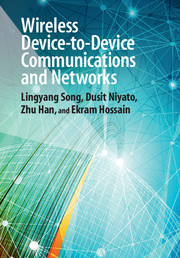Book contents
- Frontmatter
- Dedication
- Contents
- Preface
- Part I Introduction
- Part II Techniques for modeling and analysis of D2D communications
- Part III Resource management, cross-layer design, and security for D2D communications
- 4 Mode selection and resource allocation for D2D communications underlaying cellular networks
- 5 Interference coordination for D2D communications
- 6 Subchannel allocation and time-domain scheduling for D2D communications
- 7 Cross-layer design for device-to-device communication
- 8 Security for D2D communications
- Part IV Applications of D2D communications
- Part V Standardization of D2D communications
- References
- Index
4 - Mode selection and resource allocation for D2D communications underlaying cellular networks
from Part III - Resource management, cross-layer design, and security for D2D communications
Published online by Cambridge University Press: 05 March 2015
- Frontmatter
- Dedication
- Contents
- Preface
- Part I Introduction
- Part II Techniques for modeling and analysis of D2D communications
- Part III Resource management, cross-layer design, and security for D2D communications
- 4 Mode selection and resource allocation for D2D communications underlaying cellular networks
- 5 Interference coordination for D2D communications
- 6 Subchannel allocation and time-domain scheduling for D2D communications
- 7 Cross-layer design for device-to-device communication
- 8 Security for D2D communications
- Part IV Applications of D2D communications
- Part V Standardization of D2D communications
- References
- Index
Summary
Introduction
Two major requirements for the LTE-A (Long Term Evolution-Advanced) standard for 4G (fourth-generation) cellular wireless networks are the need to improve spectrum efficiency and to enhance network throughput. D2D communications technology is a promising add-on component of LTE-A systems to satisfy those requirements. The concept of D2D communications is to allow direct communications among the user equipments (UEs) by reusing the cellular resources rather than using the uplink or downlink resources of the cellular networks (see Figure 4.1). D2D communications can achieve four types of gain [161], namely proximity gain, hop gain, reuse gain, and pairing gain. In D2D communications, the UEs can operate in one of three traditional modes as follows.
• Reuse mode: D2D UEs directly transmit data among themselves by reusing some radio resources used by cellular UEs to enhance the spectrum utilization.
• Dedicated mode: D2D UEs directly transmit data among themselves by using a dedicated portion of spectrum to avoid interference with cellular UEs.
• Cellular mode: Similarly to cellular UEs, D2D UEs relay their data through the base station.
One key question here is how to select a transmission mode for each D2D link. In the cellular mode, more resources (e.g., the number of time slots) may be required for transmitting data to the receiver than in the reuse mode or dedicated mode; however, it is easier to manage interference with cellular users. The reuse mode can achieve a higher spectrum efficiency but D2D communications in this mode may interfere with cellular users and other D2D users using the cellular mode. By contrast, the dedicated mode can completely avoid interference, since some resources are reserved for the D2D communications; however, the spectrum utilization can be very poor in this mode. A simple method is to choose the mode by considering only the received signal strength over the D2D link or the distance between the terminals. However, the interference conditions and the differences between sharing cellular uplink and downlink also affect the overall network throughput.
- Type
- Chapter
- Information
- Wireless Device-to-Device Communications and Networks , pp. 129 - 159Publisher: Cambridge University PressPrint publication year: 2015



